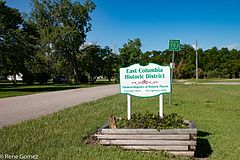United States Department of the Interior National Park Service NATIONAL REGISTER OF HISTORIC PLACES REGISTRATION FORM
The East Columbia Historic District is a small district comprised mostly of 19th century domestic buildings erected when the community of East Columbia was one of the most important inland ports in Texas. The district includes the oldest surviving neighborhood in East Columbia, a community dating to the earliest years of exploration and settlement by Anglo- and African-American colonists in Texas.
East Columbia’s subsequent rise to prominence stemmed from its strategic location on the Brazos River, which served as a major conduit for the shipping of goods to and from surrounding settlers. The river port became a vital component in the plantation-based economy that developed along the Brazos River during the 19th century. As it includes houses of merchants, plantation owners, and those involved in steamboat operations, the district is being submitted in conjunction with the Historic Context “Transportation and Settlement along the Brazos River.”
The district is nominated to the National Register under Criteria A and C as one of the few tangible links to the commercial development of the steamboat trade in the region and because the houses are noteworthy illustrations of 19th-century domestic architecture. It includes one property previously listed in the National Register (the Ammon Underwood House; NR 1976). East Columbia’s beginnings can be traced to the founding of Stephen F. Austin’s original colonization effort, commonly referred to as the “Old 300” because he agreed to introduce 300 families within a 200,000-acre land grant in Texas.
Initial settlement patterns tended to fan out from major waterways such as the Brazos River. These pioneers realized the importance of rivers for transportation purposes as well as their potential role in the economic development of the colony. With that purpose in mind, Josiah H. Bell established a site for the loading and unloading of passengers and cargo on the Brazos River in 1824. Called Bell’s Landing by the early colonists, it served as a nucleus for a town that Bell named Marion and is now known as East Columbia. The inland port played a significant role in the development of the frontier interior of Austin’s colony in a number of commercial ways: as a transportation and debarkation center for new settlers arriving in the colony; as a distribution center for their much-needed supplies; and as a loading station for the shipments of sugar, com and cotton crops cultivated after plantations were established throughout the county.
For more information about visiting and other historical sites in the area please visit: Columbia Historical Museum

